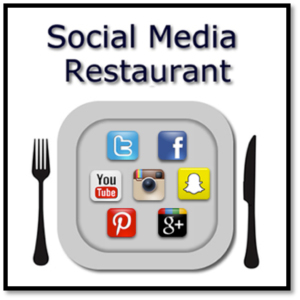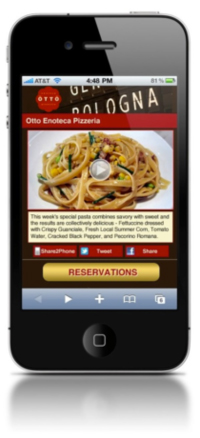 This year is going to be all about taking content to the next level—the key word here is value. A great picture of a beautiful food dish is still going to be compelling, but it’s going to be more important than ever to provide your social media audience with engaging content that invites interaction. Mobile is also going to reach the tipping point as this year will see tablet and cell phone visitors to your restaurant’s website go over the 50 percent mark. Video will be playing an even larger role in the escalating arms race to get your posts noticed, and it’s definitely be time to stake your claim on Google. Here’s the skinny:
This year is going to be all about taking content to the next level—the key word here is value. A great picture of a beautiful food dish is still going to be compelling, but it’s going to be more important than ever to provide your social media audience with engaging content that invites interaction. Mobile is also going to reach the tipping point as this year will see tablet and cell phone visitors to your restaurant’s website go over the 50 percent mark. Video will be playing an even larger role in the escalating arms race to get your posts noticed, and it’s definitely be time to stake your claim on Google. Here’s the skinny:
Value added. As stated above, it’s more important than ever to post content that doesn’t just say “Eat Here Now.” Engage your customer base with questions about how they like specific dishes, interesting info about menu items or how-to’s from the chef. Your beverage program can also offer great content possibilities with cocktail recipes and wine notes. If all else fails, just check the date—with a little help from Google you can always find something provocative that happened on a specific date and relate it to your restaurant. In other words, post things that you would want to share with a friend.
Local sourcing. Whether you’re a vegan, gluten-free, free-range advocate, or an all-out steak-craving carnivore, the one thing you have in common is that you’re probably interested in where the things on your plate originated. Restaurant goers across the board are asking more questions about where their food comes from, while studies show that as many as 70 percent of consumers are willing to pay more for locally produced food. To that end it is pretty much a no-brainer that such a pervasive and growing, trend should be an integral component on all of your social media platforms. Post Facebook updates with links to your local food suppliers. Tweet and retweet info on the same subjects and reference appropriate #hashtags so you can leverage interest in the conversation. Add a Pinterest board with photos pinned from local farms and orchards. Post Instagram pictures of raw produce and meats before they are prepared. In other words, engage your customers on a subject of increasing importance—and show yourself leading the discussion, not simply responding to a trend. Website evolution. While not strictly a social media issue, your website design and functionality are critical components in your ongoing internet marketing campaign. It is increasingly clear that your web presence is part of an overall marketing strategy that needs to work seamlessly with your social media channels. The most important development last year was the need to develop a mobile site; almost half of all consumers now reference your restaurant on a handheld device. This year it will be critically important that the platform your website is on is responsive to the increasing variety of cellphones and tablets. In my opinion Wordpress is hands down the best website software available. A robust platform that constantly evolves, it is always up to date and, with the use of the proper template, ensures that your site is usable on virtually any device. It also boasts a user-friendly interface that makes updating your website pain free—no more getting quotes from your developer for simply updating the logo. A stop gap mobile solution such as Duda Mobile is better than none at all, and it has a fairly intuitive site builder if you want to tackle it yourself. But the long-term solution is going to be a responsive theme on a Wordpress site.
Website evolution. While not strictly a social media issue, your website design and functionality are critical components in your ongoing internet marketing campaign. It is increasingly clear that your web presence is part of an overall marketing strategy that needs to work seamlessly with your social media channels. The most important development last year was the need to develop a mobile site; almost half of all consumers now reference your restaurant on a handheld device. This year it will be critically important that the platform your website is on is responsive to the increasing variety of cellphones and tablets. In my opinion Wordpress is hands down the best website software available. A robust platform that constantly evolves, it is always up to date and, with the use of the proper template, ensures that your site is usable on virtually any device. It also boasts a user-friendly interface that makes updating your website pain free—no more getting quotes from your developer for simply updating the logo. A stop gap mobile solution such as Duda Mobile is better than none at all, and it has a fairly intuitive site builder if you want to tackle it yourself. But the long-term solution is going to be a responsive theme on a Wordpress site.
Google Places. Google Pages for Business and Google + Pages are still evolving and should be working seamlessly in the near future. At the moment it remains a complicated subject that seems to change weekly (you can find more detailed info here) and I will be examining it in greater detail in a future post. The key thing is that once it coalesces into final form it will be combination of local search results and social engagement. What you need to do now, if you haven’t, is claim the Google Place account for your restaurant (it is almost certain that one already exists), verify your ownership and then make sure that all the info listed for your store is accurate. Google Place pages are very often the first thing that shows up for a on a search for your restaurant and are directly linked to your Zagat review. Here’s an example for Babbo Ristorante in NYC. Here’s a link to get you started. Google Plus has long been perceived as a party that everyone was waiting for someone else to show up to first—it’s time to make sure you’re not the last to arrive.
Food blogs. Food blogs now number in the millions and many more are started every day. They can range from the “what I made for breakfast” variety to the “where I’m eating dinner” strain and at their worst they can be uninformed and even coercive. The best are written by savvy diners who champion your finest efforts to audiences that can now range up to the tens of thousands. Make sure you engage the good ones by retweeting or linking to their blog posts and contributing value to the symbiotic relationship. It is also good practice to establish an in-house best practices guide for your employees who may be blogging and posting on their own. They can post comments about their favorite dishes, but they shouldn’t be using it as a platform to complain about the clientele.
Snapchat. This relatively new social media application rolled out just a few years ago and is incredibly popular with a very much younger demographic. Simply put, it allows you to take a picture, a la Instagram, add text and then send it to any number of Snapchat friends. The twist here is that the photo is set to delete itself after the person views it briefly—anywhere from 3 to 10 seconds. Snapchat is used predominately by people who may not be your target audience now, but will be in a few short years. It also offers intriguing marketing possibilities. By its nature, Snapchat gets the attention of the recipient because it’s not just another in a long line of posts or tweets. Set up an account for your restaurant and start recruiting followers. You can find some recent case studies here.
We’ll be providing you with more specific restaurant applications in the near future.
Video. Video content is going to be more important than ever this year. Virtually every camera or smartphone has an HD video feature, and there are a number of easy-to-use editors that are available as well (my favorite is iMovie, with a comparable app for Android users). Simple subjects such as the preparation of a signature dish or the construction of a special cocktail can be fun and easily captured. Remember: Sharing is the name of the game and video is by far the most propagated form of content across any social media channel. As Instagram becomes more seamlessly combined with Facebook you can look for more ways to cross-promote posts and maximize the value of both. The key here is don’t be afraid to take some chances. You’re not wasting film, and the worst that can happen is you just don’t use what you shot. And each time you do channel your inner Scorsese you’ll become that much more adept.
In conclusion, the most important thing to remember is to be responsive, engaging and flexible. Provide your customers and followers with a compelling reason to interact with you. All of these network marketing tools are free to use, but the value you get for the resources you devote to them is entirely up to you.
How restaurant social media will evolve in 2014
1 comment
Hide comments
